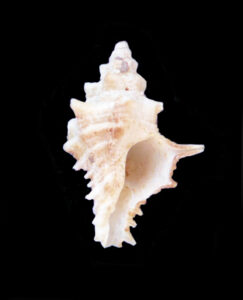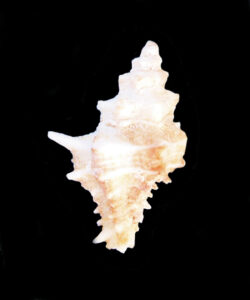Broderip’s Thistle Trophon Shell, Acanthotrophon carduus

 Broderip’s Thistle Trophon Shell, Acanthotrophon carduus. Size: 2.0 cm (0.8 inches) x 1.1 cm (0.4 inches). Shell courtesy of the commercial fishermen of the greater Los Cabos area, Baja California Sur, March 2018.
Broderip’s Thistle Trophon Shell, Acanthotrophon carduus. Size: 2.0 cm (0.8 inches) x 1.1 cm (0.4 inches). Shell courtesy of the commercial fishermen of the greater Los Cabos area, Baja California Sur, March 2018.
Phylogeny: Broderip’s Thistle Trophon, Acanthotrophon carduus (Broderip, 1833), is a gastropod mollusk that is a member of the Muricidae Family of Rock Shells. The genus Acanthotrophon is one of one hundred ninety -eight genera in this family, and there are five species in this genus.
Description: Broderip’s Thistle Trophon shell consists of seven whorls with a diamond shaped profile. Sculpting consists of nodes and spines along the tops of the whorls; more worn shells will have only spines near the aperture. The spire length is very similar to the body whorl length. The aperture is oval in shape and the inside of the outer lip is marked by a series of ridges. The siphon canal is about as long as the aperture, and is open. The exterior of the shell is scaly in texture and white in color. Some specimens have brown blotches or or brown node tips. The interior is white. Broderip’s Thistle Triton Shells reach a maximum of 2.8 cm (1.1 inches) in length and 1.5 cm (0.6 inches) in height.
Habitat and Distribution: Broderip’s Thistle Tritons are found attached to rocks and are found at depths between 12 m (40 feet) and 100 m (330 feet). They are a tropical Eastern Pacific species. In Mexican waters they range from Mulegé, Baja California Sur, in the Gulf of California, to Guatemala. They are absent from the west coast of the Baja Peninsula.
Ecology and Behavior: Broderip’s Thistle Tritons are predators that feed primarily on shelled invertebrates. They are gonochoric and reproduce sexually. There is no mention in the available literature of them engaging in any types of parasitic, commensal, or symbiotic relationships. From a conservation perspective they have not been formally evaluated however they are fairly common with a relatively wide distribution and should be consider to be of Least Concern.
Synonyms: Murex carduus